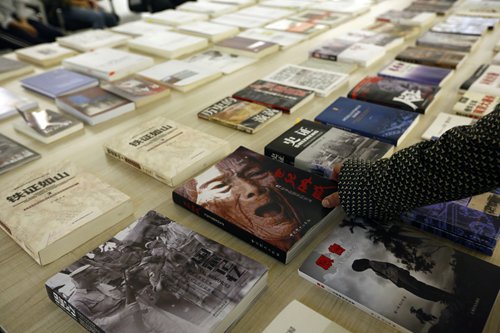
A visitor picks out a book on China's "comfort women" Saturday at a newly opened museum at Shanghai Normal University.
Museum details fading history of Japan's 'comfort women' system
Shanghai's first museum dedicated to World War II's so-called "comfort women" opened to the public Saturday. Located on the campus of Shanghai Normal University, the museum exhibits cultural relics donated by the survivors of wartime Japan's system of forced sexual slavery. Currently, only 19 "comfort women" are still alive in Chinese mainland.
The collections exhibited in the museum include the condoms used in the various sites, called comfort stations; victims' travel documents from attending hearings against the Japanese army after the war; their passports used to enter Japan for their lawsuits; as well as their handprints and footprints, thepaper.cn reported.
Two living "comfort women" from Hainan Province and South Korea attended the museum's opening ceremony, where they shared their stories of suffering and demanded an apology from the Japanese government, the Xinhua News Agency reported.
Chen Liancun, 90, wept upon seeing her photo displayed in the museum. She was first sexually assaulted by three Japanese soldiers at the age of 13, when she was tending to cows on a hillside pasture.
Three years later, she was captured by a stronghold of the Japanese army, forced to do the washing and cooking for the Japanese during day and raped by them at night.
"I won't forget the savagery of the Japanese soldiers. I hope to get justice. I demand an apology and compensation from Japan," Chen said.
"Victims' testimony along with historical evidence from the museum prove that the 'comfort women' system was a national crime of wartime Japan. It was a crime against humanity," said Su Zhiliang, the head of the Research Center for Chinese Comfort Women at Shanghai Normal University, the Xinhua News Agency reported Sunday.
Su has been doing research on "comfort women" for 20 years. He said that thousands of comfort stations were scattered across China. His compiled map of these confirmed comfort stations is on exhibit in the museum. However, many addresses are still listed as unknown.
"Some locations of comfort stations were confirmed by memoirs of old Japanese soldiers, in which they remembered there was a comfort station on a certain road. However, that place may no longer exist. There is no way to locate the accurate address," thepaper.cn quoted Su as saying.
"Sometimes doing historical research is just full of regrets. We can't confirm without seeing historical materials, but we can assure that there used to be a comfort station on this road," Su said.
During World War II, over 400,000 Asian women were forced into Japanese military brothels as sex slaves, and half of them were Chinese, according to Research Center for Chinese Comfort Women at Shanghai Normal University.
Since the 1990s, around 100 victims have stepped forward to expose sexual slavery by the Japanese army and have sued the Japanese government. However, many of them are now reaching the end of their lives.
Last year, Zhang Xiantu, the last living Chinese victim involved in the suit, passed away before getting the apology for which she'd waited 70 years.
For Su and his colleagues, as the living victims get older, living in pain and illness, they are also running against time to document history.
"There are only 19 confirmed 'comfort women' left in the Chinese mainland. They are all in advanced years, so we have to make the best use of time, preserving their historical evidence, making handprints and footprints and recording their testimony. Because that generation will finally pass away," Su said.
Some of the footprints are displayed on the university's campus, together with a bronze statue of "comfort women."
The statue named Peace Maid was created by Chinese and South Korean artists. It consists of statues of a Chinese maid, a South Korean maid and an empty chair.
Behind the Chinese maid extends a trace of footprints collected from the living "comfort women," representing their long journey.
One of these footprints was collected from an old woman in Shanxi Province. She has a pair of 3-inch "golden lotuses," the term for a woman's bound feet done in China's feudal era.
"Her feet were contorted, so it was hard for her to escape after being caught by the Japanese. Through these handprints and footprints, we can tell the hardship they experienced," Su said.
Professor Pan Yiqun from Tsinghua University, one of the designers of the statues, said that one model was erected in Seoul last fall, and the one unveiled in Shanghai is the second made from the mold.
He said a group of statues are to be displayed all around the world in the future.
Su said the biggest progresses in research on "comfort women" was that figuring out the basic facts and outlines of the system, as well as raising public awareness.
This year Su and his co-workers updated the map of comfort station, adding four sites, for a current total of 170 in Shanghai. After last year's map was released, he received a letter from an old man asking if the site he had seen as a boy was a comfort site as well.
"Certainly more and more people are starting to focus on this issue because of our research," Su said.
"Now content about 'comfort women' also appears in history books in middle school and high schools, which is a progress itself."
In 2014, China and South Korea applied to UNESCO to have "Voices of Comfort Women" added to the UNESCO Memory of the World Register.
Shen Huixiu, the person in charge of the application said that though the application met opposition from Japan, people would still strive to protect and utilize the historical archives to make contribution to the peaceful development of the world.


















































